STORY HIGHLIGHT
Iran is using an app called ‘Nazer’ to track women without the “mandatory” headscarves in public. Independent International Fact-Finding Mission on the Islamic Republic of Iran reported it on Friday (March 14).

Key Points
- Research suggests Iran is using the Nazer app to report women not wearing hijab, expanding surveillance since September 2024.
- The evidence leans toward the app enabling uploads of vehicle details, flagging violations, and threatening impoundment, raising human rights concerns.
- It seems likely that this enforcement, including drones and facial recognition, is part of broader repression, as noted in a recent UN report.
Background
Iran has enforced mandatory hijab laws since the 1979 Islamic Revolution, with the morality police, or Gasht-e Ershad, patrolling to ensure compliance. Recent developments show a shift toward technological enforcement, particularly with the Nazer app, which allows citizens and police to report violations, especially in vehicles.
Details on the Nazer App
The Nazer app, lets users upload a vehicle’s license plate, location, and time if a woman is not wearing a hijab. It flags the vehicle online, alerts police, and sends real-time warnings to owners, with threats of impoundment for non-compliance. Since September 2024, it has expanded to target women in ambulances, taxis, and public transport, indicating a wider scope of surveillance.
UN Findings and Implications
A UN report from March 14, 2025, by the Independent International Fact-Finding Mission on Iran highlights this as part of systemic human rights violations, accusing Iran of crimes against humanity in repressing dissent, especially against women and girls. It notes increased enforcement via the “Noor plan” since April 2024, with penalties like fines and prison for activists, and mentions a suspended draft law proposing up to 10 years in prison and death penalties for non-compliance.
Unexpected Detail
An unexpected aspect is the use of facial recognition at Amirkabir University since early 2024 to monitor students, showing how educational institutions are also targeted.
Comprehensive Analysis: Iran’s Use of the Nazer App for Hijab Enforcement
This analysis delves into Iran’s use of the Nazer app for enforcing mandatory hijab laws, as highlighted in a recent UN report. It examines the app’s functionality, its expansion, and the broader implications for human rights, particularly in the context of ongoing protests and international scrutiny. The report, released on March 14, 2025, by the Independent International Fact-Finding Mission on the Islamic Republic of Iran, provides critical insights into the state’s escalating surveillance tactics.
Historical Context of Hijab Enforcement in Iran
The mandatory hijab law was instituted following the 1979 Islamic Revolution, led by Ayatollah Khomeini, marking a significant shift in women’s public dress codes. Initially, enforcement varied, but over time, it became stringent, with the morality police, or Gasht-e Ershad, patrolling streets to ensure compliance. These units have the authority to detain women not properly covered, imposing fines or other punishments. Recent years have seen fluctuations, with 2024 witnessing the opening of non-hijab treatment clinics, interpreted by some as support for non-compliance and by others as stigmatization.
The Nazer App: Functionality and Expansion
The Nazer app, a government-backed tool, is accessible via Iran’s police (FARAJA) website. It allows users, including civilians collaborating with government committees, to report women not wearing hijab, particularly in vehicles. Users can upload the vehicle’s license plate, location, and time, which flags the vehicle online, alerting police. The app sends real-time text messages to owners, warning of violations and threatening impoundment for non-compliance. Since September 2024, its scope has expanded to include women in ambulances, taxis, and public transport, indicating a broader surveillance net.
This expansion reflects a strategy to mobilize state-sponsored vigilantism, encouraging businesses and private individuals to participate in hijab enforcement, framing it as a civic duty. The app’s use by informants patrolling streets has led to systematic reports, often resulting in vehicle impoundment, further restricting women’s mobility and rights.
Technological Surveillance Beyond the App
The UN report details additional surveillance methods, including aerial drones monitoring women in public spaces and facial recognition software installed at Amirkabir University in early 2024 to detect non-compliant students. These technologies, combined with the Nazer app, create a comprehensive surveillance state, particularly targeting women and girls, and are part of a broader effort to crush dissent.
UN Findings: Human Rights Violations and Crimes Against Humanity
The UN Fact-Finding Mission’s report, based on 38,000 pieces of evidence and 285 interviews, accuses Iran of systemic human rights violations and crimes against humanity in repressing dissent, with a focus on women and girls. It notes that since April 2024, the “Noor plan” has intensified enforcement, with increased police presence and criminal prosecution against women defying the mandatory hijab. Women human rights defenders face fines, lengthy prison sentences, and, in some cases, the death penalty for peaceful advocacy.
The report also references a draft “Hijab and Chastity” law, suspended in December 2024, which proposed severe penalties, including up to 10 years in prison, fines up to $12,000, and the death penalty under Article 286 for “corruption on earth”. This legislative context underscores the state’s intent to escalate repression, despite pre-election assurances by President Masoud Pezeshkian to ease enforcement.
Implications and International Response
The use of the Nazer app and other technologies raises significant concerns about privacy, civil liberties, and women’s rights, contributing to a culture of fear and self-censorship. Human rights organizations, such as Amnesty International, have called for increased international scrutiny and accountability, urging member states to renew mandates for monitoring Iran’s human rights situation (Amnesty International).
The report’s findings are particularly poignant in the context of the “Woman, Life, Freedom” protests following Mahsa Amini’s death in September 2022, which resulted in hundreds of deaths and thousands of arrests, highlighting the state’s violent response to dissent (CNN). The international community is urged to take action, with the UN mission recommending steps to address these violations and promote human rights in Iran.
Conclusion
Iran’s use of the Nazer app for hijab enforcement, as detailed in the UN report, represents a significant escalation in surveillance and repression, with profound implications for women’s rights and human rights at large. As the situation evolves, global attention and action remain crucial to uphold international standards and support those advocating for change in Iran.
Previous Posts:-
- Trump takes U-turn on running for presidency in 2028, backs JD Vance, Rubio: Here’s what he said
- RBI keeps repo rate unchanged at 5.5% amid Trump tariff threat
- Shocking Claim: Zelensky claims Chinese Fighters in Russia’s Ukraine War
- Triumphant: Royal Anniversary Vatican Visit Amid Italian State Trip
- Trump Slaps 125% Tariffs on China, Offers 90-Day Tariff Pause for Negotiating Nations





Leave a Reply